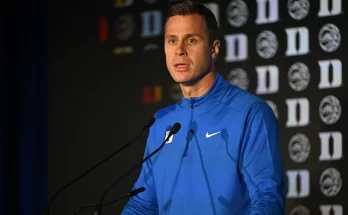The air in Gainesville holds a palpable weight of nostalgia and homage today, as the Florida Gators prepare to welcome back one of their earliest heroes. Steve Spurrier—Heisman Trophy winner, transformative head coach, beloved ambassador—has made a pilgrimage home, not as a conquering hero seeking accolades, but as a devout pilgrim paying final respects to the program that shaped his life and ultimately shaped college football itself.
Spurrier’s return to “The Swamp” is steeped in symbolism. It’s a moment that bridges eras, melding memories from the vibrant 1960s when Spurrier first donned the orange and blue, through his groundbreaking coaching career in the 1990s, and into the present day where his presence once again lends luster to a new generation of Gator athletes. As he sets foot on the 50‑yard line, where once he commanded the offense with daring brevity, the stadium seems to exhale—a collective reminder of who built the foundation of Florida’s football greatness.
The story begins in 1966, when Spurrier, a young and astute quarterback, captured the Heisman Trophy, etching his name permanently in Gator lore. He was the first in school history to earn that honor, a milestone that signaled a shift in the perception of Florida football from regional competitiveness to national relevance ([floridagators.com][1]). That victory opened doors not only for Spurrier himself, who went on to a brief professional career, but also for the generations of athletes who followed in his wake.
A quarter‑century later, in 1990, he returned—not as a player now, but as the head coach charged with revitalizing the same program. It didn’t take long for “The Head Ball Coach”—a moniker he earned through his brash charisma and offensive ingenuity—to leave an indelible mark. In just his second season, Spurrier led the Gators to their first Southeastern Conference title in 1991. He would ultimately guide the team to six SEC championships and, in 1996, their inaugural national championship, defeated FSU in the Sugar Bowl 52–20 .
Under Spurrier’s reign, Florida became electrified by the “Fun ’n’ Gun” offense, a high-flying, pass-heavy attack that uprooted the traditional college game. Stadiums brimmed, recruiting reached new heights, and college football witnessed a revolution. When the stadium itself was officially named Steve Spurrier–Florida Field at Ben Hill Griffin Stadium in 2016, it felt less like a ceremony and more like destiny fulfilled ([miamiherald.com][2]).
Yet, for all the accolades and triumphs, Spurrier’s return today is not about embellishment—it’s about closure, gratitude, celebration, and homecoming. Aging yet still sharp, he arrives carrying more than memory; he carries the emotional weight of a lifetime intertwined with Florida football.
The Gators recently announced his appointment as Athletic Department Ambassador, a role befitting a man who has embodied Gator values—competitive fire, wit, intelligence, connection—for over fifty years ([floridagators.com][1]). His presence behind the scenes may not be symbolic alone; it’s practical mentorship. Athletic director Jeremy Foley summed it up: “It’s a credit to Jeremy \[Foley] to get him back home where he belongs… I look forward to actually talking to him and being around him rather than just saying hello to his statue on my way to work every day.” Coach Jim McElwain echoed that sentiment, anticipating spirited conversations and insight ([floridagators.com][1]).
Back in 2017, his return to Gainesville grew personal, as Spurrier chose to settle permanently near campus in Oakmont with his wife, Jerri. No longer content living quietly on Crescent Beach, he resettled among tidings of orange and blue—so he could remain connected, engaged, supportive—not merely nostalgic ([palmbeachpost.com][3]).
Today, under overcast skies and stirring echoes of chant (“Steve! Steve! Steve!”), he stands at midfield once more. He wears a Gators hat and visor, hands resting lightly in pockets, the weight of half a century of history coursing through him. Around him, modern players take note. They speak in hushed reverence: “He’s the reason this program exists the way it does.” Some quietly trace their fingers over the bronze Spurrier statue outside, a tribute unveiled alongside that of Tim Tebow and Danny Wuerffel in 2011 ([espn.co.uk][4]).
At this moment, Spurrier offers no speeches—today isn’t about oratory. Instead, he allows the setting to speak: The names engraved on rings of honor, the banners hanging above, the turf that now bears his name. He walks the sidelines, pats a helmet here, shakes a young player’s hand there. He listens, nods, smiles wryly.
But this isn’t about a single visit—it’s a process of farewell. Not a goodbye—he’s not leaving again—but a final chapter. One player whispers that at times, this program may seem bigger than the man; but today, he reminds them exactly who built the foundation it stands on.
Former teammates, assistant coaches, university leaders and boosters all surround him. They look on through a mixture of pride, gratitude, and melancholy—as though saying a respectful goodbye, marking an endpoint in an extraordinary chapter of school lore. Spurrier, for his part, seems grateful. His few words of thanks—heard later in a video released by the university—were simple: “To the incredible Gator Nation, thank you for embracing me and all I’ve been privileged to be part of. You made my time in Gainesville unforgettable.” His tone, thick with emotion, suggested this final return was as meaningful as his first touchdown in 1964 .
That emotion elicits reflection. What Spurrier meant to Florida is immeasurable. He awakened the sleepy giant—a program that had never tasted national victory—to the possibility of sustained dominance. He created a style and swagger that redefined the campus culture. He forged connections that transcend wins and losses, rooting in the hearts of alumni and new fans alike.
His legacy is shared famously in lore: the bold halftime adjustments, the jabs at rivals (who could forget “You can’t spell ‘Citrus’ without ‘UT’”?) ([reddit.com][5]), the habit of punting on third down, the gleaming smile under that ever-present visor. He was part tactician, part showman—but always authentically Spurrier.
Today, as he scans the field, he pauses momentarily at the bullpen sideline. Coaches and players stand aside respectfully. He nods to each—acknowledging them with the same ease he once deflated opponent defenses. A few of the young players hesitantly offer greetings; he smiles, shakes hands firmly, then lets them know, “That’s how you do it out there.” And in that brief exchange lies his essence: always teaching, always challenging, always guiding.
Inside the stadium, the crowd feels it. From the upper deck, you can see fans craning to get another look at the man who once galvanized the Gators. They clap, chant, stand. Some grasp the orange-and-blue scarves tighter, as though that connection spans decades. Social media lights up: memories posted, photos shared, memories tagged #HBC, #FunNGun, #SteveReturns.
For university administrators, this moment is substantial. It reaffirms the identity they’ve long cultivated—the lineage of excellence, the reverence for tradition, and the continual thread of connection between past and present. It’s no surprise Spurrier maintains an active role as Ambassador—he’s not merely a figurehead, but an active participant in mentoring programs, athletic development, and alumni engagement .
As the day progresses, and the stadium empties, Spurrier’s final act unfolds: a private visit to his statue, a moment of reflection before the bronze figure. A lone security guard ensures privacy. Spurrier stands before it, hat in hand. He gazes up, shoulders relax slightly, lips press in a grin. For a moment, time stands still.
In that pause, one senses gratitude—for teammates, coaches, players, fans—every person who joined him in that improbable journey from Heisman hopeful to national champion to university icon. It’s a farewell, yes, but also a benediction.
He turns away, shoulders squared. He’s no longer chasing records, championships, or headlines. He’s simply a man bidding farewell to the place that gave him identity.
On his way out of the stadium, he greets the few remaining custodians, volunteers, and staff still lingering from the day’s event. They cheer. He waves. He’s still, as ever, stand-up, genuine, ready to engage—one last time in the spotlight he helped create.
By nightfall, Spurrier will likely gather with old friends in downtown Gainesville—tales will be told, toasts made, stories swapped. A few beers or sodas perhaps, laughter and verse exchanged. In the morning, he’ll drive back to Oakmont, open the door, hug Jerri, and reflect on a full, storied life that came alive here, in this place.
And what now? Although this visit marks a farewell of symbolic significance, his impact will live on. The football field carries his name; the statue bears his likeness; the banners recount his championships. But more enduring than that is the culture he built: the expectation of excellence, the audacity to dream on a national stage, the tradition of innovation, and the intimate relationship between coach and community.
New coaching staffs, rising players, even a revived stadium name—they all share a lineage with Spurrier. Each time a Gator kid straps on pads and repeats the Gator Chomp, they tread in his footsteps.
For the fans who have followed the Gators since the ’60s, the ’90s, and even last season, this visit is more than a ceremony. It’s a heartfelt goodbye from a man who did more than coach—it was an invitation to believe.
As he exits campus under the light of a retiring June sun, Spurrier’s legacy looks forward as well as back. His return and this final salute are reminders to the next generation that greatness isn’t just inherited—it’s earned, built with vision, grit, charisma, and unwavering belief in what can be accomplished. And though the man is stepping away from the spotlight, his story remains woven into the fabric of the University of Florida—eternal, honored, venerated.
Steve Spurrier came home one last time to say thank you—not for the statue or Heisman or title banners—but for the family, the fans, the lifelong community that made his legend possible. In return, the University of Florida embraces him one final time with that same reverence and unending gratitude. And perhaps that mutual affirmation—man and alma mater, intertwined forever—offers the truest, purest coda to an extraordinary symphony composed over decades, echoing in The Swamp, flourishing under ancient oak, and inspiring long after the lights have dimmed.


